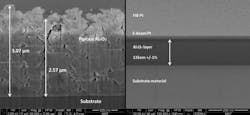Picodeon Ltd Oy (Ii, Finland) has developed an ultrashort-pulsed-laser-deposition (USPLD) surface-coating technology that can create either porous or dense aluminum oxide (Al2O3) coatings on heat-sensitive substrates.
The coatings are intended for industrial metallization applications. For example, porous Al2O3 layers are used as filters and electrical insulation layers, while dense Al2O3 is used as a barrier layer—and is also an excellent optical coating with high transmittance.
“It is currently very difficult to achieve these results using physical-vapor-deposition (PVD), sputtering, or chemical-vapor-deposition (CVD) surface-coating technologies,” says Picodeon VP Sales and Business Development Marko Mylläri.
The company's Coldab Series4 equipment has online plasma monitoring and laser power measurement to achieve precise management of coating process parameters, as well as computer-controlled automation that records the actions of the coating process..
Test production runs showed that the system can improve the porosity of a 3-µm-thick Al2O3 coating, for example, from 10% to as much as 45% by tuning the scanning speed and laser repetition rate.
Al2O3 coatings on heat-sensitive materialsThe Al2O3 coatings were applied on heat-sensitive polyethylene (PE) and thermoplastic polyurethane (TPU) polymer film substrates. This is possible due to the low process temperatures required for surface coating using Picodeon’s USPLD system—one of the major benefits of the process, says the company.
In addition to Al2O3, the process can be used for other coatings as well, including gold, copper, and oxides such as titanium dioxide (TiO2).
For more info, see http://www.picodeon.com/.

